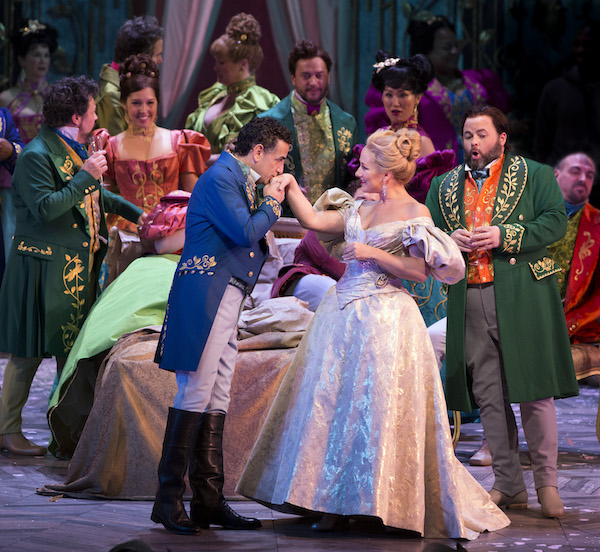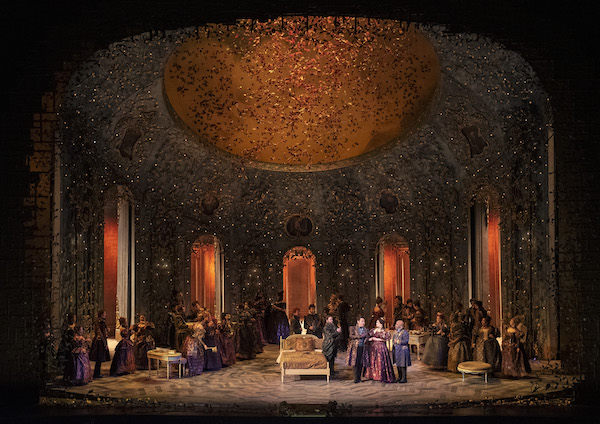A glitzy new “Traviata” ushers in the Nézet-Séguin era at the Met

Diana Damrau and Juan Diego Flórez star in the new production of Verdi’s “La Traviata” at the Metropolitan Opera. Photo: Marty Sohl.
The Yannick Nézet-Séguin era at the Metropolitan Opera has officially begun.
Having moved up his start date to the beginning of this season, the conductor made his first appearance as the company’s music director Tuesday night, leading a new production of Verdi’s La Traviata. There was no mistaking the festive atmosphere, with a starry cast onstage, confetti cannons at Nézet-Séguin’s curtain call, and even splits of prosecco labeled “Vintage Yannick” passed out as the audience left the house.
Unfortunately, too much of that confetti-and-bubbles frivolity crept into the new staging as well. This has been a busy season for director Michael Mayer, who created the production of Marnie that premiered in October. This new Traviata is the first big miss of his young Met career, offering a glitzy confection with a too-clever concept.
The heavy foreshadowing in both Verdi’s score and Francesco Maria Piave’s libretto leaves little doubt as to how the opera will turn out: we see from the start that the legendary courtesan-socialite Violetta is ill, and that her blissful fling with the young Alfredo will be her last. The Overture begins with icy chords that look ahead to her final illness in Act III, and Mayer takes that as his cue to construct a pantomime scene that shows her in her palatial bedroom, surrounded by the same characters who are with her in her last moments. Snow falls in through the open roof, placing us in winter, and each subsequent scene has the bedroom outfitted for a different season, all of these episodes apparently taking place in Violetta’s imagination as she lies dying.
The suggestion that “it’s all a dream” feels glib to begin with, but the execution of the production is clumsier still. The palette Susan Hilferty chooses for the period “spring” costumes in Act I seems pulled out of some brightly lit Disney film while Christine Jones’s sets barely change: for Act II, the ornate floral trellises around the edges of the room get pulled away from the walls, and a menacing chandelier of autumn leaves is flown in through the hole in the ceiling for Flora’s party. All of this takes place in Violetta’s bedroom— we have to keep reminding ourselves that the center-stage bed is the central element in the conceit, and not just a piece of furniture left there by accident.
Mayer has a gift for visual flair, and his Traviata does boast some vivid images, such as the gargantuan silhouettes of manic Carnaval revelers that haunt Violetta’s windows in Act III. But the striking effects are lost in a sea of strange decisions—most bewildering of all being the choice to actually supply Germont père’s daughter onstage when he visits Violetta and Alfredo’s secret retreat. “Pura siccome un angelo,” Germont’s humble plea with Violetta to give up the affair for the sake of his family, becomes a cold act of emotional blackmail with her present: “Look at this sweet girl–you wouldn’t want to ruin her life, would you?” After her thirty seconds in the spotlight, Mlle. Germont retreats back behind the trellises where she lurks awkwardly by the door for the rest of the scene. Even stranger, she doesn’t come back out ten minutes later for Violetta’s confrontation with her brother Alfredo: apparently someone has to keep an eye on the horse-drawn carriage.

Photo: Jonathan Tichler
Diana Damrau’s appearance as Violetta marks a reprise of her run in the previous Willy Decker production in 2013, also with Nézet-Séguin. She showed remarkable control on Tuesday, flowing easily through the florid lines of “Sempre libera,” leaving room for nuance where other sopranos simply have to drive through in order to register all the notes. To be sure, her voice has lost something since that 2013 run–occasionally she’ll push a high phrase and the result is a hard, stretched sound.
But she’s lost none of the energy or emotional intelligence that make her such a compelling actress. Act III’s “Addio del passato” was achingly crafted, its desperation growing out of a quiet sadness. Her voice had settled into its best form by this point, as well, sounding warm in middle range that makes up the core of the aria.
Fresh off his Carnegie recital last month, Juan Diego Flórez returned to the Met stage for the first time in several years. Alfredo is a bit of a stretch for the Peruvian tenor. While the role’s extremes lie easily within his reach, the part is not a natural fit for his timbre—mostly staying away from the high-flying top range that shows off his exceptional ring, and living much more in the middle where his voice has less color. “Un dì, felice” sounded almost too easy, as he barely had to expend any effort to reach the top of the climactic phrases. He is, though, a marvelous performer, mostly keeping a vivacious energy on Tuesday but coming down from it in crucial moments, such as the tender, heartbreaking duet “Parigi, o cara.”
Quinn Kelsey is fast becoming a baritone superstar. There is a gorgeous roughness in his tone, giving his full-bodied voice a rich grain and color that make it unmistakable. His take on Germont was stern, but that only made his moments of humility all the more poignant. His unaffected, moving rendition of “Di provenza il mar” was of course a highlight, but it was his Act II scene with Violetta that was especially memorable, as his gristly baritone and her penetrating soprano clashed in emotionally wrought exchanges.
Among the supporting cast, Kevin Short stood out as Dr. Grenvil for his round, full bass-baritone, and Dwayne Croft was imposing as Alfredo’s rival Baron Douphol, bringing a lean, taut baritone to the role. Maria Zifchak provided a steady hand as Violetta’s kindly servant Annina, while Kirstin Chávez had more of a struggle as Flora, her mezzo sounding weary and hard. The Met’s choristers sang with buoyant energy all night, sounding especially fresh as the chorus of gypsies and matadors in Act II.
It may have been a milestone night for Nézet-Séguin, taking up the reins at one of the world’s most important cultural institutions, but this was not among his most memorable pit performances. His leadership was certainly capable, yet the orchestra playing lacked the excitement he usually brings—the sluggish tempos in Act I, especially, made the opening party scene feel a little dreary.
Crucially, though, the orchestra sounded lustrous under his baton, the strings finding every chance to gleam. The closer collaboration between Nézet-Séguin and the Met Orchestra is a partnership to look forward to, one that he honored when he invited the entire pit onstage for the final bow.
La Traviata runs through December 29 at the Metropolitan Opera. A spring cast, featuring Anita Hartig as Violetta, Stephen Costello as Alfredo, and Artur Ruciński and Plácido Domingo as Germont, opens April 5, with Nicola Luisotti conducting. metopera.org






Posted Dec 22, 2018 at 2:21 pm by Nonny Rankin
Turning the Verdi/Piave magnificent Love Story into an outright Elegy is a travesty; a Vile Misrepresentation. The subtle nuances of Violetta’s illness, in a well produced Traviata, progressively BUILDS THE DRAMATIC TENSION in this opera.
To open with the Death Bed…and portray a cheap Hollywood style ‘flashback’ production, is an offence to every intention Verdi/Piave had.
To have this ridiculous Death Bed, central in center stage throughout, destroyed the essential and beautiful dramatic progression of this Opera.
I was sickened. I had to walk out of the HD Broadcast in Montreal during the second intermission. I am disgusted that Mayer et al. DARED TO DESECRATE THIS CLASSICAL AND MOST BEAUTIFUL WORK OF VERDI.
If This is the New Met with Yannick. God help us all!
Nonny Rankin Montreal, Quebec, Canada
Posted Apr 07, 2019 at 4:25 pm by CAL
I love Verdi’s LaTraviata. Since I‘ve seen it at least three times before, I was disappointed w/the gaiety of the party & the dances seemed “Over he Top”, so suggestive, with men shirtless & the dancers being thrown around from one man to another, I really am old fashioned. It’s such a beautiful opera, & of course I adored Luciano Pavarotti & remember his tremendous talent. The young performers’ singing was easy on the ear, so I enjoyed their interpretations of their characters. I’m so happy that the Met offers these operas on Great Performances. Thank you.